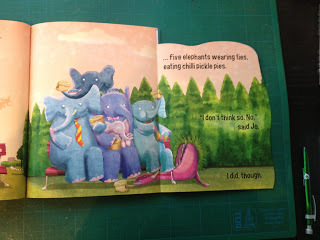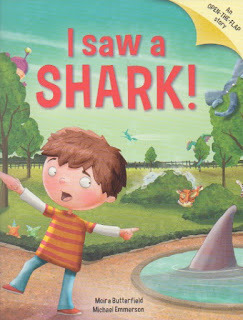Inspiration for picture books with added features - by Moira Butterfield
Some picture books have extra features. Board books, of course, have many incarnations, but I’m going to concentrate on classic picture book pages here and provide some references that may perhaps help to inspire you to ideas of your own.
Here are examples what I mean by ‘extra features’.
Gatefolds – A gatefold is a page that has been made double the size and then folded back over on itself to make an extra-big flap. It can be diecut, which means that parts of the paper are cut away to create shapes.
Gatefolds can be both left and right, up at the top of a page or down at the bottom. My new picture book – I Saw A Shark – was written specifically to use a righthand gatefold on every spread. The story relies on the finding of a hidden surprise on every spread by extending the picture using a gatefold.



Diecutting – Ordinary pages can be diecut, which is the term for paper having shapes cut out of it. Pages might have holes in them so the reader can see through to other pages, or the paper edge can be cut to a new shape.
The classic example of a picture book with holes in it is Peepo, created by Janet and Alan Ahlberg in 1981 and reprinted ever since. The text prompts the reader to look through a hole in each page. Here’s a youtube version of Alan Ahlberg reading it and if you haven’t come across it before it before, you can see how it works from the video.
https://www.youtube.com/watch?v=H_3bRQFs7Sc
Dos and don'ts - The trick to writing a story for a picture book with added features is to incorporate the features into the telling, so that playing with them is an integral part of the story. Peep-through holes and gatefolds lend themselves to elements of surprise in a story.
Revelling too much in the cleverness of the features and not providing a strong enough story is the trap to be wary of. I think illustrators in particular sometimes get carried away with the excitement of manipulating paper and think it’s enough to carry the whole book.
The right publisher - I was lucky with I Saw a Shark to find a publisher who specifically wanted to produce books with extra play value. If you have a story idea that relies on extra features you need to find the right publisher - one who has this type of book on their list and is prepared to invest in the extra paper costs and manufacturing costs involved.
Inspiration - If you’d like to venture down this route I suggest doing some research online and in your local bookshop, to find some examples that might inspire you. There are some interesting books around at the moment (especially in the USA) and luckily for us they tend to have presentation reels on youtube. I’ve added a few here to help you get started. I haven’t road-tested them with children, mind you, but they all have interesting features that might inspire you to something.
I say go for it if you have a good idea, and anyway it seems a valid creative exercise to sit down for an hour or two and play around with thoughts using some of these examples. It may lead you down unusual paths.
So...Here are some links to get you thinking. Have fun!
Beautiful Oops – by US musician Barney Satlzberg. There’s every kind of added feature in here to show you the art of the possible.
https://www.youtube.com/watch?v=2fZjMYdQjGM
There are No Cats in this Book – and others in the same series by Viviane Schwartz. Lots of fun. Uses extra features in a really entertaining way.
https://www.youtube.com/watch?v=0r1PHxhWXD0
Flora the Flamingo – and others in the series by US artist Molly Idle. There are no words, but it may inspire you because it so cleverly shows how paper can be used to change a scene (in this case flaps).
https://www.youtube.com/watch?v=9d3llsrs7tc
Moira Butterfield www.moirabutterfield.com@moiraworld
New picture books: I Saw a Shark - illustrated by Michael Emmerson - Published by Milly and Flynn Everybody Feels series - illustrated by Holly Sterling - Published by QED
Here are examples what I mean by ‘extra features’.
Gatefolds – A gatefold is a page that has been made double the size and then folded back over on itself to make an extra-big flap. It can be diecut, which means that parts of the paper are cut away to create shapes.
Gatefolds can be both left and right, up at the top of a page or down at the bottom. My new picture book – I Saw A Shark – was written specifically to use a righthand gatefold on every spread. The story relies on the finding of a hidden surprise on every spread by extending the picture using a gatefold.



Diecutting – Ordinary pages can be diecut, which is the term for paper having shapes cut out of it. Pages might have holes in them so the reader can see through to other pages, or the paper edge can be cut to a new shape.
The classic example of a picture book with holes in it is Peepo, created by Janet and Alan Ahlberg in 1981 and reprinted ever since. The text prompts the reader to look through a hole in each page. Here’s a youtube version of Alan Ahlberg reading it and if you haven’t come across it before it before, you can see how it works from the video.
https://www.youtube.com/watch?v=H_3bRQFs7Sc
Dos and don'ts - The trick to writing a story for a picture book with added features is to incorporate the features into the telling, so that playing with them is an integral part of the story. Peep-through holes and gatefolds lend themselves to elements of surprise in a story.
Revelling too much in the cleverness of the features and not providing a strong enough story is the trap to be wary of. I think illustrators in particular sometimes get carried away with the excitement of manipulating paper and think it’s enough to carry the whole book.
The right publisher - I was lucky with I Saw a Shark to find a publisher who specifically wanted to produce books with extra play value. If you have a story idea that relies on extra features you need to find the right publisher - one who has this type of book on their list and is prepared to invest in the extra paper costs and manufacturing costs involved.
Inspiration - If you’d like to venture down this route I suggest doing some research online and in your local bookshop, to find some examples that might inspire you. There are some interesting books around at the moment (especially in the USA) and luckily for us they tend to have presentation reels on youtube. I’ve added a few here to help you get started. I haven’t road-tested them with children, mind you, but they all have interesting features that might inspire you to something.
I say go for it if you have a good idea, and anyway it seems a valid creative exercise to sit down for an hour or two and play around with thoughts using some of these examples. It may lead you down unusual paths.
So...Here are some links to get you thinking. Have fun!
Beautiful Oops – by US musician Barney Satlzberg. There’s every kind of added feature in here to show you the art of the possible.
https://www.youtube.com/watch?v=2fZjMYdQjGM
There are No Cats in this Book – and others in the same series by Viviane Schwartz. Lots of fun. Uses extra features in a really entertaining way.
https://www.youtube.com/watch?v=0r1PHxhWXD0
Flora the Flamingo – and others in the series by US artist Molly Idle. There are no words, but it may inspire you because it so cleverly shows how paper can be used to change a scene (in this case flaps).
https://www.youtube.com/watch?v=9d3llsrs7tc
Moira Butterfield www.moirabutterfield.com@moiraworld
New picture books: I Saw a Shark - illustrated by Michael Emmerson - Published by Milly and Flynn Everybody Feels series - illustrated by Holly Sterling - Published by QED
Published on February 08, 2016 00:48
No comments have been added yet.



